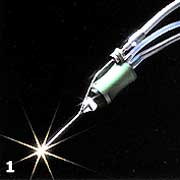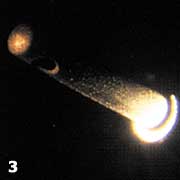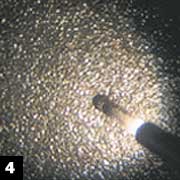Illuminated vitrector allows easier one-handed surgery
The site is visualized by the same handpiece that performs cutting maneuvers, making removal of the vitreous base easier and safer.
Click Here to Manage Email Alerts
MONZA, Italy – A new vitrector with incorporated crescent-shaped illumination combines the functions of the two instruments normally used for vitreous surgery, leaving one hand free and enabling the surgeon to perform this delicate procedure without the help of a second person.
The new vitrector, named Videm, was designed by Vito De Molfetta, MD, and is produced by Optikon.
“In traditional pars plana vitrectomy, the infusion cannula, the vitrector probe and the illumination handpiece are introduced through three separate scleral incisions,” Prof. De Molfetta said.
“Removing the central vitreous is relatively simple, but the upper part of the vitreous base, which is more directly in contact with the retina, can be a problem for the surgeon. There the vitreous is denser, as it is richer in collagen fibers. It is therefore difficult to cut and remove it safely from the underlying retina. In such a position, illumination and visualization are also a problem,” he said.
He explained that two techniques have developed in recent years. One uses the coaxial light of the surgical microscope, with or without prismatic lens. The other technique permits the insertion of vitrector and light through two separate incisions.
“The new Videm vitrector makes the removal of the vitreous base easier and safer, because the site is visualized by the same instrument that will perform the cutting, introduced through a single scleral incision,” he said.
Effective illumination and cutting
Videm is a 20-gauge cylindrical instrument with 160 quartz optic fibers, each 30 µm in diameter, eccentrically arranged with respect to the blade to form a luminous crescent (figures 1, 2).
“The optic characteristics of the fibers (N.A. 0.66 and ![]() 83°) and the shape in which they are disposed produce a light without shadows, mainly concentrated on the cutting mouth of the vitrector, but also allowing effective illumination in front and around it (figures 3, 4),” Prof. De Molfetta said.
83°) and the shape in which they are disposed produce a light without shadows, mainly concentrated on the cutting mouth of the vitrector, but also allowing effective illumination in front and around it (figures 3, 4),” Prof. De Molfetta said.
A xenon generator provides the energy for the high-quality, intense lighting produced by the instrument, which is more powerful than halogen light but causes no trauma to the periphery of the retina.
The vitreous cutter consists of a self-sharpening, guillotine blade with a cutting mouth of 0.5 mm by 0.32 mm, which is smaller than that of a traditional 20-gauge vitrector. The cut rate performs up to 1,000 cpm with a suitable control unit. The foot switch controls both aspiration and cutting.
“The vitreous in front of the probe is directly visualized and removed right down to the retinal surface,” he said.
Because of the reduced dimensions of the cutting mouth, the presence of mobile retina in the periphery is not to be considered a contraindication to the use of Videm.
| ||||||||
Better endoillumination
“The advantage of having to hold just one instrument is that we can use other surgical accessories with the other hand whenever it is necessary, without the help of a second operator,” Prof. De Molfetta said.
In the aphakic eye, one hand only can be used to remove the vitreous base on 360°. In the phakic eye, he recommends that vitrectomy of the left part of the eye be performed with the left hand, and vice-versa.
“Since in both cases the vitreous base cannot be visualized, the surgeon himself or herself can indent the pre-equatorial sclera with the instrument, varying the pressure and inclination of the probe to visualize the vitreous fibers without damaging the lens,” he said.
“This gives a much better internal vision of the eye than the illumination systems traditionally used. Even the illuminated scleral depressor is not as effective as the Videm because it relies on the transmitting properties of the scleral, uveal and retinal tissues.”
Minimizing risks
Recommended parameters for base vitrectomy are IOPs of 20 mm Hg to 25 mm Hg, cutting speed 700 cpm, aspiration 100 mm Hg to 150 mm Hg.
“These parameters allow removal of the peripheral vitreous with minimal traction on the retina,” Prof. De Molfetta explained.
The vitrector probe is semi-disposable and can be used a minimum of 20 times. The illumination system is independent, and does not need to be replaced with the vitrector. Both parts are autoclavable at 134°.
Prof. De Molfetta defined the new Videm system “the best, user-friendly instrument available to visualize and remove the peripheral vitreous minimizing the risk of retinal breaks and lens damage.”
He considers it particularly indicated for situations where the removal of the vitreous base is essential to the outcome of surgery, such as anterior proliferative vitreoretinopathy, giant breaks, retinal detachments in pediatric age, diabetic retinopathy with new vessel formation in the medium and distant periphery.
For Your Information:
- Vito De Molfetta, MD, can be reached at Ospedale San Gerardo, Clinica Oculistica, Monza, Italy; (39) 039-233-4726; fax: (39) 039-233-4777; e-mail: ocumonza@hotmail.com. Dr. De Molfetta has no direct financial interest in the products mentioned in this article, nor is he a paid consultant for any companies mentioned.
- Optikon SpA, manufacturer of the Videm, can be reached at Via del Casale di Settebagni 13, 00138 Rome, Italy; (39) 06-888-8355; fax: (39) 06-888-8388; Web site: www.optikon.com.




